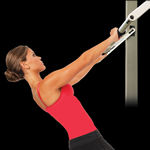by Michael Stefano
The dog days of summer are upon us, but you don’t have to put your exercise program on the back burner just because it’s too hot to workout. There are steps you can take to safely and comfortably exercise during the sweltering summer months, but first let’s take a short look at how the body responds to training in the heat.
When exercising in climates that are hotter than you are used to, blood vessels near the your skin have to open to permit the transfer of body heat to the environment. This forces the heart to work a little harder as it supplies the muscles with an adequate amount of blood (and oxygen). At any give pace, heart rates will therefore be higher than usual, as the cardiovascular system attempts to meet the fuel supply of working muscles. An obvious solution is to just slow down.
Sweating is another way the body regulates its internal temperature. Sweat evaporates on the skin and effectively removes body heat. High temps, when combined with high humidity, are especially stressful for any unacclimated individual. Sweat can’t evaporate when the air is laden with moisture, and this interferes with the body’s process of heat dissipation.
So how can we minimize these risk factors and get the most out of our summer workout program? Here are ten hot tips to make exercise safe and effective all summer long.
Ten Hot Weather Workout Tips:
1. Stay hydrated
- Before Exercise: Drink 8 ounces of water 30 minutes prior
- During Exercise: Drink 3 to 6 ounces of water every 15 minutes
- After Exercise: Drink 8 ounces of water in the 30 minutes following
2. Back off intensity levels. When training in the heat, you won’t have to work as hard to elevate heart rate. Take this into consideration, and closely monitor your heart rate during aerobic exercise. Adjust down your pace accordingly.
3. Avoid training during the hottest times of the day. Take advantage of the extra daylight. Early morning and evening hours can provide us with a window of coolness to get in a workout.
4. Take the workout indoors. I personally love training outdoors whenever possible, but exercising in an air-conditioned house or gym can provide you with total protection from the heat. An exercise bike, treadmill, or a simple set of dumbbells can provide you with the tools to exercise at home.
5. Adjust clothing. Lightweight, loose fitting, and light colors. Experts recommend cotton over synthetics. Don’t skip the socks. Light cotton socks will protect the feat and help whisk sweat away.
6. Find a cool place. Wherever you happen to live, there are certain areas where joggers and walkers flock to because it’s cooler. It could be the boardwalk, if you leave near the ocean, or just a shady path in a local park. Seek out the coolest places to train.
7. Work out in the water. Find a local pool and switch to swimming as your aerobic workout, or just do water aerobics in the backyard pool. Either way you’ll get a great workout
8. Keep your face and neck clear. If you have long hair, pull it back and up. Remove all jewelry that can generate friction. Also remove any make up and allow the skin to breath.
9. Give yourself a couple of weeks. The human body is an amazing machine that will adjust to almost any condition. Back off intensity levels as you allow the body 10 to 14 days to acclimate itself to the hot weather.
10. Don’t exercise if the heat index is too high. Sometimes, you have to know when to just don’t do it. If you can’t bring the workout indoors, and into an air-conditioned environment, play it safe and take the day off. See the heat index or apparent temperature chart below for guidelines:

A Word About Hyperthermia
To avoid a possible heat-related injury, the main concern is fluid replenishment and maintaining adequate hydration. Hyperthermia, or simply too much heat, is a condition that affects the human body on three levels:
- Heat Cramps: Cramps or muscle tightness experienced in dominant muscles such as calves and abdominals.
- Heat Exhaustion: Characterized by sweating profusely, but your skin will appear cool and clammy. Body temps will still be at normal levels.
- Heat Stroke: At this point the skin will turn dry and red. Sweating will stop as the body tries to conserve water. Core body temperatures of 105 degrees are possible, and this can be life threatening if left unchecked. Loss of consciousness is possible.
If you suspect that you are experiencing any of the symptoms of hyperthermia, STOP EXERCISING. Get out of the hot environment as soon as possible and replenish fluids. If caring for someone else with suspected hyperthermia, and they lose consciousness, do not attempt to give anything by mouth. For simple heat cramps, stretching can also be helpful.
Be especially careful when training in hot whether if you’re obese, unfit, dehydrated, or have a previous history of heat stroke.
Following the above tips will keep you safe and exercising all summer long. Remember, when training in the heat, keep intensity levels down, and above all stay hydrated. Enjoy your summer!
About the Author: Michael Stefano, New York City firefighter and author of The Firefighter’s Workout Book, The 30 Minute-a-day Train-for-life Program for Men and Women. Special Offer: Lose weight and get in shape with the FREE Train For Life Newsletter.










